There are thousands of different types of daisy flowers that grow throughout the world that many of us have come across in our lives. How many times growing up, did you utter the words “they love me, they love me not” while picking the petals off a daisy flower? This simple childish game answered our biggest question about the love in our life — do they love me as much as I love them? Daisies are beautiful flowers beloved by people of all ages because of the variety of gorgeous colors to choose from and how easy it is to grow.

Let’s discover ten types of daisy flowers and why you should take a closer look at these beautiful flowers the next time you see them.
1. English Daisy
Also known as the common daisy or lawn daisy, the English daisy (Bellis perennis) is one of the most common daisy species. While native to Europe, the English daisy has taken over many Australian and American lawns that don’t clear from mowing and are quite invasive — hence the name “lawn daisy.”
The English daisy is a herbaceous perennial plant that blooms from March to September. They have a beautiful disk-like center and a rosette of spoon-shaped white petals. The plant is roughly 12 inches tall and wide. What makes them so special is that the flowers will follow the sun’s position throughout the day.

Also known as “lawn daisies,” English daisies (pictured) are invasive to lawns in many American and Australian gardens.
©M9K/Shutterstock.com
2. African Daisy (Osteospermum)
Osteospermum is a genus of flowering species and looks similar to the common daisy with its disk-like shape center and rosette petals. However, the flower petals can be smooth or tubular, depending on the species. Colors vary in radiant purple, yellow, white, and pink.
As the name suggests, the African daisy is native to Africa but also found in some parts of the Arabian peninsula. There are roughly 70 species of African daisies, with many cultivars and hybrids. They are mostly perennial plants and will bloom before mid-summer and again after, as they don’t tolerate summer heat.
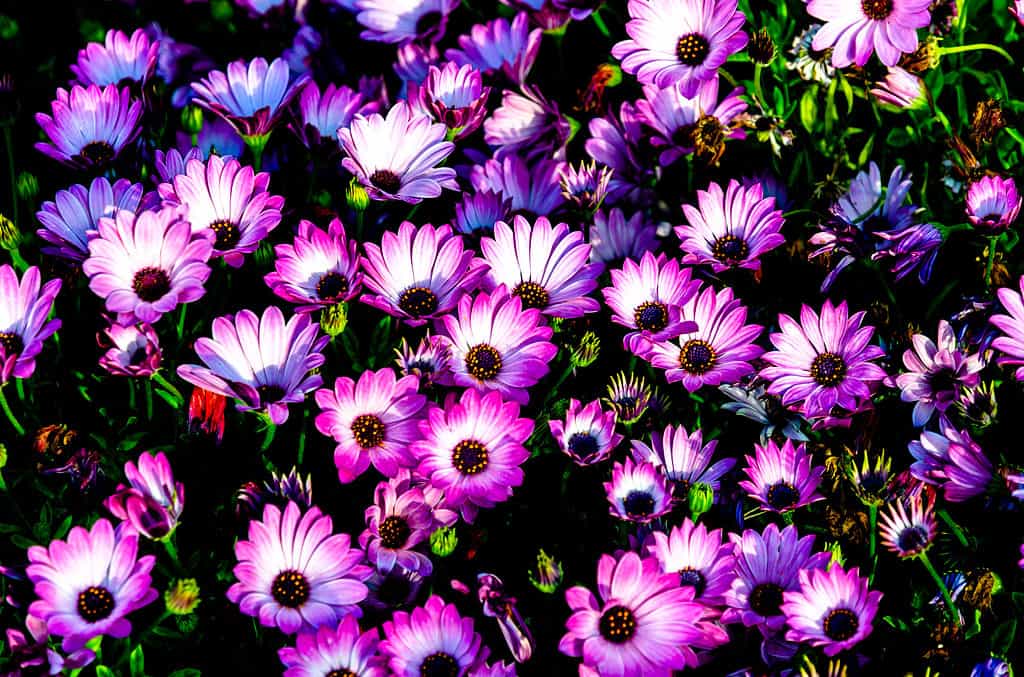
The African daisy (pictured) has a typical daisy shape with a rosette of vibrant-colored petals and a disk-like center.
©Martin Kovacik/Shutterstock.com
3. Gerbera Daisy
The gerbera daisy (Gerbera jamesonii) is a type of daisy flower endemic to the Limpopo and Mpumalanga provinces in South Africa and Eswatini, formally known as Swaziland in Southern Africa. Other common names you may recognize are the Transvaal daisy and the Barberton daisy.
These brightly colored flowers are often grown in containers by plant lovers and make beautiful flower arrangements. Gerber daisies are perennial herbs that grow about 18 inches tall and produce vibrant red-orange flowers. These dazzling ornamental flowers bloom from the start of summer through fall.
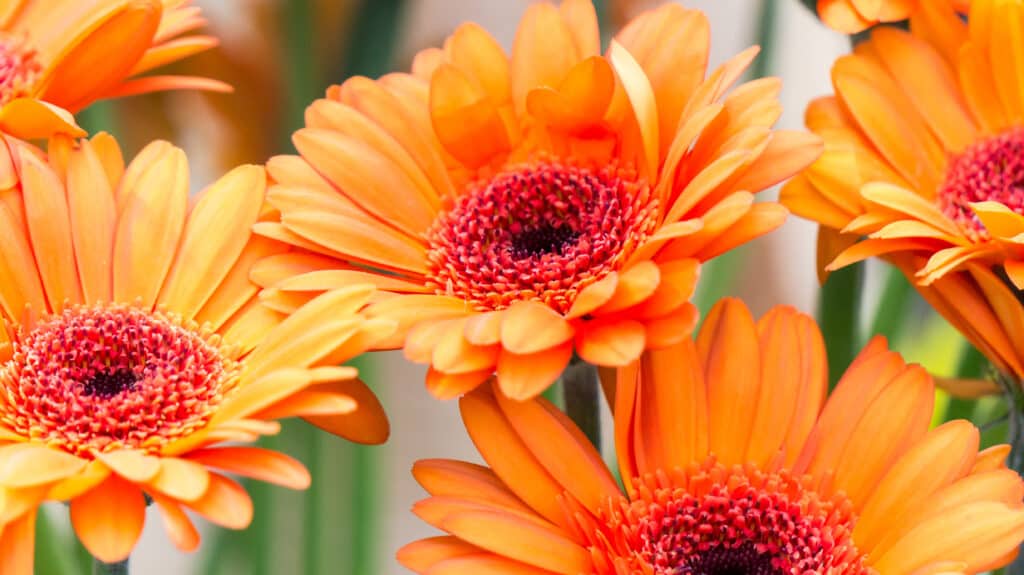
The Gerbera genus consists of 22 different species, including
Gerbera jamesonii(pictured).
©Andrey Shepetov/Shutterstock.com
4. Black-Eyed Susan Daisy
The black-eyed Susan daisy (Rudbeckia hirta) is a wildflower known as the gloriosa daisy. In 1918, Maryland named black-eyed Susan its state flower. The beautiful daisy’s color of black and gold even inspired the University of Southern Mississippi school colors. They are native to North America and naturalized in China.
Black-eyed Susan has thick stems that stand straight up with flowers in various shades of mahogany and gold with a dark brown center. These beautiful summer flowers bloom from June to August. Black-eyed Susans are popular garden flowers and look great when grown in bunches.
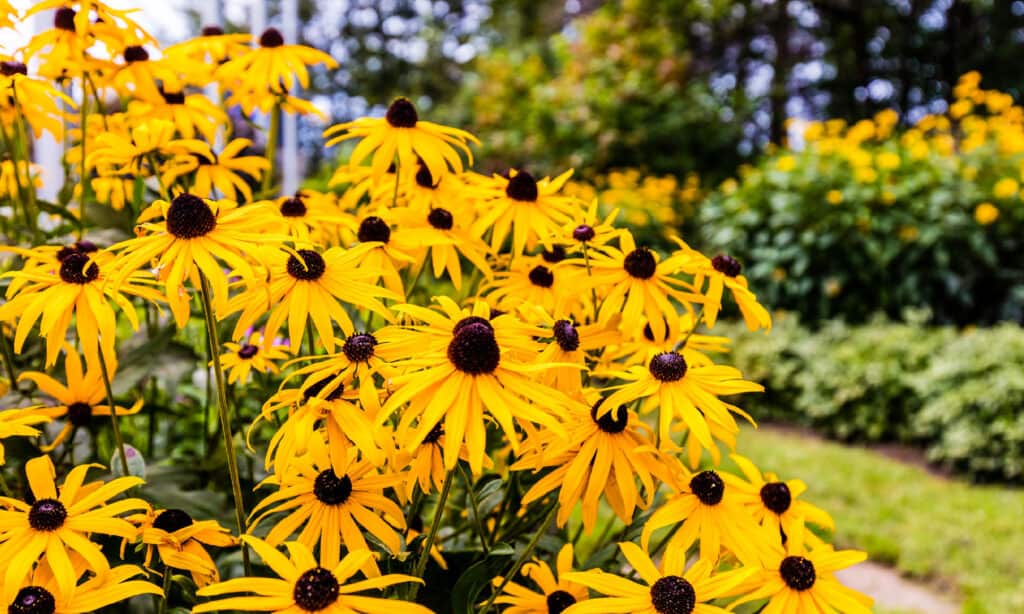
The black-eyed Susan (pictured) is Maryland’s state flower.
©iStock.com/Dopeyden
5. Golden Marguerite Daisy
The golden marguerite daisy’s binomial name is Cota tinctoria. However, the horticulture industry still refers to it by its synonym, Anthemis tinctoria. Another common name for golden marguerite is yellow chamomille due to its faint aroma. These beautiful flowers are native to Europe and Western Asia, but you can find them throughout North America.
The leaves are feathery with a fine texture, and the stems reach 2 feet tall when they mature. Golden marguerite has deep yellow petals, and flowers bloom in the summer. They are toxic to animals and should get grown away from pets.

The golden marguerite daisy (pictured) should be kept away from pets as they are toxic to animals.
©DSGNSR1/Shutterstock.com
6. Blue-Eyed African Daisy
The blue-eyed African daisy (Arctotis venusta) is a South African ornamental plant that got naturalized in Australia, South America, and some parts throughout the United States. Common names include “Kus Gousblom,” “Karoo marigold,” and “silver Arctotis.”
The showy flowers have a mauve center with a yellow ring at the base of the white petals connecting to the center of the flower. They grow about 19 inches tall and develop into a bush, making them great for the use of ground cover.

The blue-eyed African daisy (pictured) consists of beautiful white flowers with a yellow ring of yellow at the base of the petals.
©RukiMedia/Shutterstock.com
7. Desert Star
The desert star (Monoptilon bellioides) is native to the Mojave Desert in California and Sonoran Deserts. They grow in deserts and can survive with little rain. However, few will grow more than half an inch, but with rainfall, expect about a 10-inch plant.
Also known as the Mojave desert star, this low-growing plant has small flowers, white to pale pink petals, and yellow centers with hairy, linear leaves.
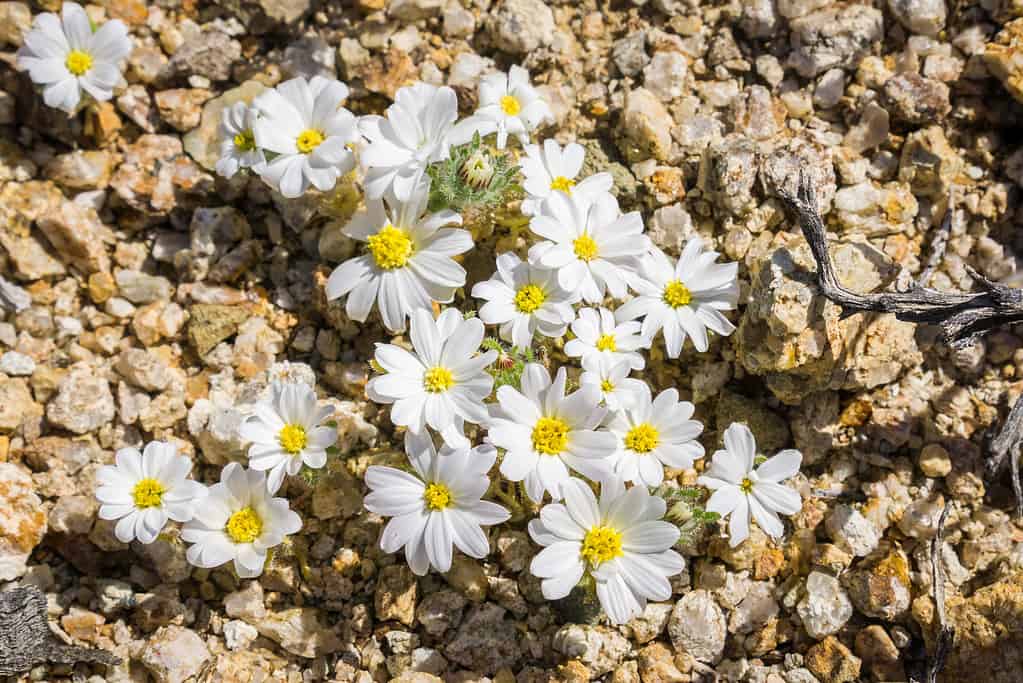
The desert star (pictured) are small plants that can survive desert heat with little rain.
©Sundry Photography/Shutterstock.com
8. Ox-Eye Daisy
The ox-eye daisy (Leucanthemum vulgare) has many common names, including “dog daisy,” “common marguerite,” and “moon daisy.” They are herbaceous perennials that grow natively in Europe and temperate areas in Asia. Today, their distribution stretches as far as Australia and North America.
The petals of ox-eye daisies are bright white with a striking flat, yellow center, which resembles the eye of an ox. The plants grow around 3 feet tall and 1-2 feet wide, with stems that can branch out to produce two flowers.
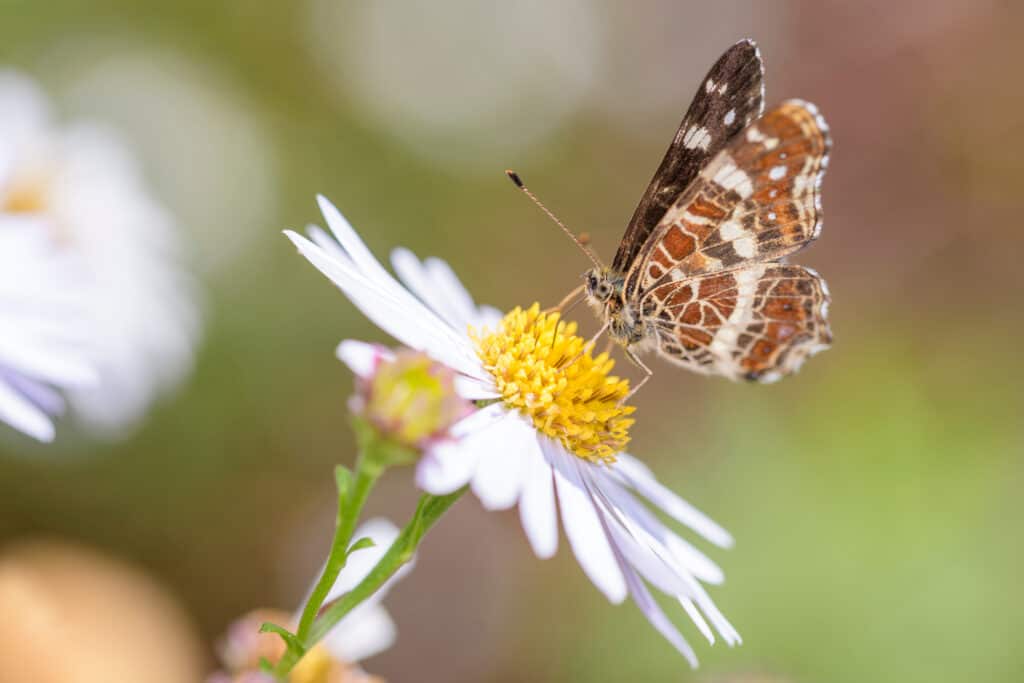
Ox-eyed daisies (pictured) have white petals and a flat, yellow center that resemble an ox’s eye.
©Dirk Daniel Mann/Shutterstock.com
9. Last Chance Townsend Daisy
The Last Chance Townsend daisy (Townsendia aprica) is endemic to Utah and a threatened species in the United States. Threats to this rare daisy species include oil and gas production, road construction, and grazing by livestock.
Last Chance Townsend only grows in clumps less than an inch tall. Since they don’t have long stems, the flowers grow in these small, bushy-like formations on stalks. They have rough, hairy leaves that are less than half an inch in size.

The Last Chance Townsend is native to Utah and is a rare daisy species.
©USFWS Mountain-Prairie, CC BY 2.0 <https://creativecommons.org/licenses/by/2.0>, via Wikimedia Commons – License
10. Painted Daisy
You’re in for a treat! The painted daisy (Tanacetum coccineum) is native to Asia and is also known as the pyrethum daisy. These easy-to-grow perennial plants will offer growers weeks of striking colors in their gardens throughout spring and summer.
Painted daisies come in a variety of colors, including crimson, pink, white, and purple. The 3-inch flowers have the same round shape as the common daisy with a round golden center. They can grow up to 3 feet tall and 2.5 feet wide. Painted daisies are beloved, vibrant garden daisies that’ll attract butterflies to your outdoor space.
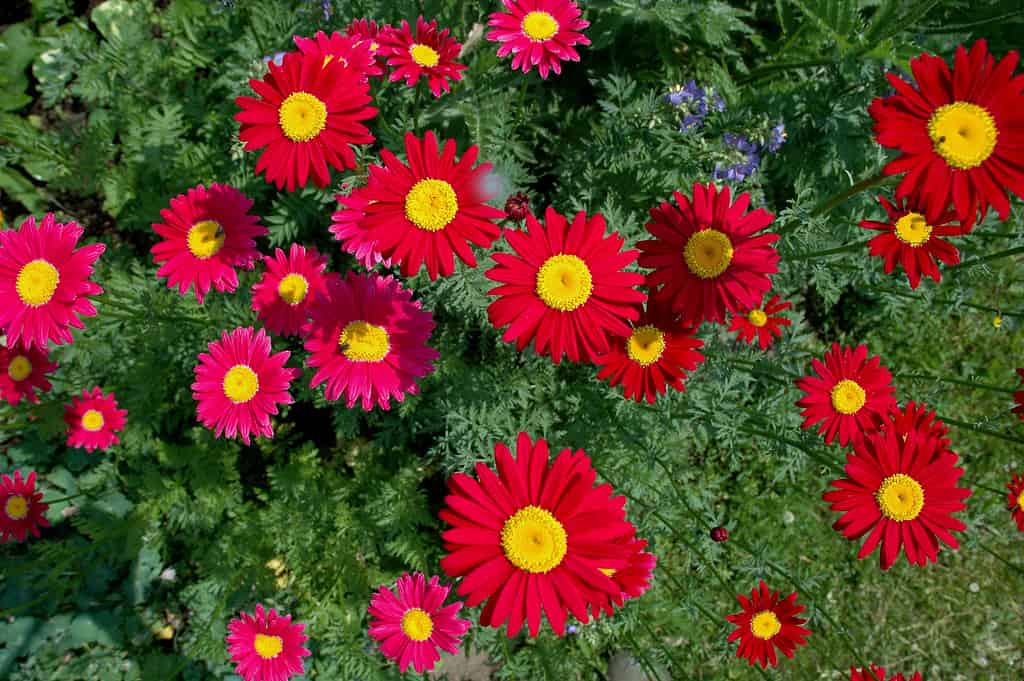
Painted daisies (pictured) give a vibrant display of brightly colored flowers in the summer and spring.
©Dajra/Shutterstock.com
Final Thoughts
There are thousands of types of daisy flowers, and each one has its own unique beauty. They come in all shapes, sizes, and colors. Some have bright-colored petals, while others have white or yellow petals. Some daisy varieties have dark centers with white petals, while others have light centers with dark petals. Many of which look like they come out of a Jane Austin novel. Daisy varieties make excellent additions to any garden or yard.
Summary of 10 Types of Daisy Flowers
| # | Daisy | Appearance |
|---|---|---|
| 1 | English Daisy | White flowers with yellow disc-shaped centers |
| 2 | African Daisy | Vibrant white, pink, purple, or yellow flowers with disc-shaped centers |
| 3 | Gerbera Daisy | Vibrant red-orange flowers with disc-shaped centers |
| 4 | Black-Eyed Susan Daisy | Mahogany or gold flowers with raised brown centers |
| 5 | Golden Marguerite Daisy | Golden yellow flowers with yellow disc-shaped centers |
| 6 | Blue-Eyed African Daisy | White flowers with a blueish-purple disc-shaped center framed by a yellow rim |
| 7 | Desert Star | White to pale pink flowers with hairy, raised yellow centers |
| 8 | Ox-Eye Daisy | White flowers with a flat yellow center |
| 9 | Last Chance Townsend Daisy | Pale, green-yellow flowers with pale yellow centers, grow in clumps |
| 10 | Painted Daisy | Brilliant pink, purple, crimson, or white flowers with yellow disc-shaped centers |
The photo featured at the top of this post is © iStock.com/skymoon13
Thank you for reading! Have some feedback for us? Contact the AZ Animals editorial team.






